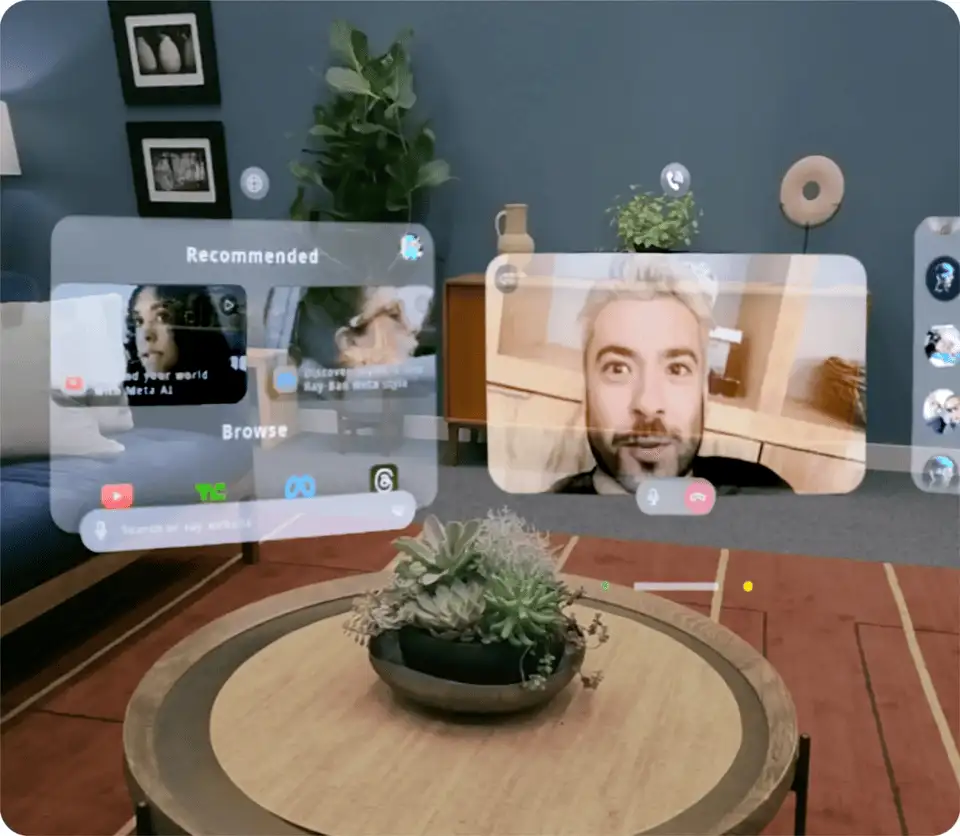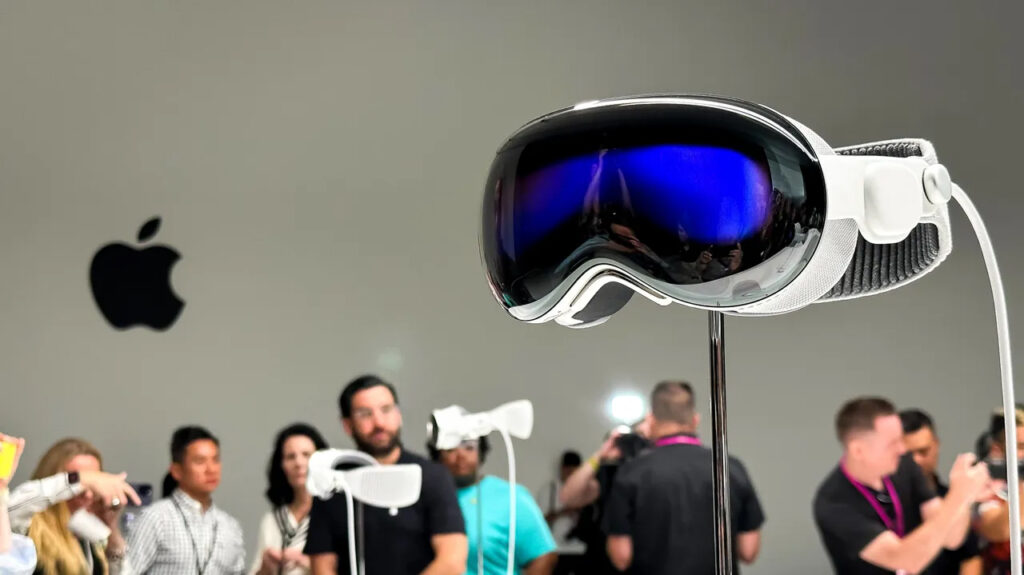- 14.03.2025
- 14 min read
- Artur Tereshchuk


Imagine walking down the street and seeing digital signs floating in the air, personalized shopping recommendations appearing in your line of sight, or even getting real-time navigation overlaid on the road itself, all without pulling out your phone. That’s the magic of Augmented Reality (AR). It’s already here, quietly revolutionizing the way we interact with the world.
At its core, the purpose of augmented reality is simple: to seamlessly blend the digital and physical worlds, making everyday tasks easier, more interactive, and—let’s be honest—way cooler. The benefits of augmented reality extend far beyond entertainment and gaming. Sure, Pokémon GO made AR famous, but today’s comprehensive AR & VR solutions are transforming industries like education, healthcare, retail, and manufacturing. Imagine students using AR to explore the human body in 3D or mechanics troubleshooting a jet engine with real-time digital overlays. The uses of augmented reality are expanding faster than ever, so let’s dive in and explore what’s coming next.
Those familiar with the topic and how immersive technologies work can skip right ahead to the state of the market section. But if you are like many others lost in all these AR-XR-MR abbreviations, then this is a must-read:
Imagine pointing your phone at a restaurant menu and instantly seeing 3D previews of the dishes appear in front of you. Or wearing a pair of sleek AR glasses that display real-time translations as you explore a foreign country. That’s Augmented Reality in action—a seamless fusion of the digital and physical worlds designed to make life more interactive, efficient, and immersive.


Augmented reality overlays computer-generated information onto the real world in real time. AR enhances what’s already there and works by using a combination of:
Right now, augmented reality solutions are accessible through several devices:
AR is often confused with other immersive technologies like Virtual Reality and Mixed Reality (MR). While they share similarities, each serves a distinct purpose.
Both Mixed Reality and Augmented Reality blend the digital and physical worlds, but MR goes one step further by making digital objects interactive within a real-world space.
🔹 AR = Digital elements overlay the real world but don’t fully integrate. Example: Pokémon GO, where digital creatures appear in real-world locations.
🔹 MR = Digital elements interact with the real world and can respond to physical objects. Example: Microsoft HoloLens, where users can move and manipulate 3D holograms.
Think of AR as adding an Instagram filter to your surroundings, while MR is more like a sci-fi movie where holograms react to your environment. But while the proper MR implementation is still far from us, AR is already here and making a change.
The biggest contrast between Virtual Reality and Augmented Reality is immersion.
🔹 AR = Enhances reality by overlaying digital elements. Users remain aware of their surroundings.
🔹 VR = Replaces reality entirely, immersing users in a digital world using a headset.
For example, a VR headset like Pimax 5K XR transports you to a virtual environment where you can walk through a fantasy world. Meanwhile, an AR headset like Oculus Quest 3 overlays 3D digital elements onto your real-world space, so you can interact with both at once.
Both AR and VR fall under the broader category of Extended Reality, which encompasses all immersive digital experiences.
🔹 AR (Augmented Reality) = Digital content overlays the real world.
🔹 VR (Virtual Reality) = Full immersion in a digital environment.
🔹 MR (Mixed Reality) = Digital and physical worlds interact in real-time.
The future of augmented reality is moving toward a seamless blend of all these technologies, creating a future where digital and physical worlds coexist effortlessly.
The future of augmented reality is unfolding at an astonishing pace, with the AR/VR market experiencing rapid expansion across industries. As businesses recognize the benefits of augmented reality, investment in AR solutions is surging.
AR & VR market size accounted for USD 59.81 billion in 2024, and market analysts predict that by 2030, the global AR/VR market will surpass $200 billion, growing at a compound annual growth rate (CAGR) of over 22%. Looking further ahead, some forecasts suggest it could reach an astonishing $589 billion by 2034. This dramatic rise is fueled by increasing consumer demand, the expansion of industrial augmented reality, and major advancements in both hardware and software. The adoption of AR is no longer limited to tech giants and startups—industries ranging from medicine and education to retail and automotive manufacturing are integrating AR into their daily operations.
Right now, the future of augmented reality is being shaped by some of the world’s biggest tech companies, each racing to develop cutting-edge augmented reality solutions that will define how we interact with digital content in the years ahead. While AR is still evolving, its growing adoption across industries has turned it into a battleground for innovation, with companies investing billions in research and development. Tech giants like Apple, Meta, Samsung, and Google are leading the way, each offering unique advancements in AR hardware, software, and AI-driven integrations.
Meta is charging full steam ahead in the augmented reality arena, with 2025 shaping up to be a pivotal year for the tech giant. In a candid internal memo, Chief Technology Officer Andrew Bosworth dubbed 2025 as the “most critical year” in his tenure, emphasizing that the company’s efforts could be seen as either visionary or a legendary misadventure.
Meta has been one of the most aggressive augmented reality companies, betting heavily on AR as the foundation of its Metaverse vision. While the company is best known for its VR-focused Quest headsets, it has also made significant strides in the AR wearables market, particularly through its partnership with Ray-Ban. The Ray-Ban Meta smart glasses, launched in 2024, offer a sleek, stylish alternative to bulky headsets, allowing users to capture photos, record videos, and access AI-powered digital assistants directly through their glasses.
However, Meta’s ambitions go far beyond simple smart glasses. In 2025-2027, the company is set to launch new high-end models, including a headset codenamed Hypernova. Unlike previous iterations, this device will feature an integrated AR display, allowing users to view notifications, interact with AI assistants, and access contextual information without looking at their phones. Priced around $1,000, the Hypernova aims to bridge the gap between traditional smart glasses and full-fledged AR headsets.
Meta’s strategy is clear: make AR an integral part of daily life by blending AI and AR into a seamless experience. The company envisions a future where AI-powered augmented reality assistants provide real-time guidance, translate languages, and offer hands-free interaction with digital content. If successful, Meta could establish itself as the leader in everyday AR wearables, setting the stage for broader consumer adoption.
Apple has been on a rollercoaster ride in the augmented reality landscape, with its Vision Pro headset taking center stage. Launched in early 2024, the Vision Pro was Apple’s ambitious leap into mixed reality, blending virtual and augmented experiences. Despite its cutting-edge technology, the headset’s steep $3,499 price tag and a limited array of compelling applications led to a lukewarm reception. This tepid response has been a tough pill for Apple to swallow, especially with CEO Tim Cook’s vision of the device revolutionizing personal technology.

Initially, Apple also planned to develop lightweight, everyday AR glasses that could offer augmented reality benefits without the bulk of a headset. However, due to technical difficulties and escalating costs, the project—codenamed N107—was shelved. Instead, Apple has redirected its focus toward improving the Vision Pro experience, integrating AI-driven AR features that could eventually pave the way for a more refined, consumer-friendly AR wearable in the future.
While Apple and Meta have taken an aggressive approach to AR hardware, Samsung has been quietly working behind the scenes on its own augmented reality solutions. In collaboration with Google and Qualcomm, Samsung is developing Project Moohan, an extended reality (XR) headset designed to integrate AR and VR capabilities into a single, user-friendly device. Unlike standalone AR glasses, Project Moohan is expected to offer a full spatial computing experience, leveraging Google’s Android XR platform to deliver immersive digital interactions.

Samsung’s approach to the future of augmented reality is strategic. Rather than rushing a product to market, the company is focusing on refinement and ecosystem integration. Project Moohan will reportedly feature advanced AI capabilities, enabling more intuitive interactions, personalized recommendations, and real-time adjustments to user environments. By working closely with Google, Samsung aims to create a device that not only competes with Apple’s Vision Pro but also establishes a broader Android-based AR ecosystem.
Google has a long history with augmented reality examples, from early experiments with Google Glass to its more recent ARCore platform for mobile devices. Now, the company is making a significant push into AR wearables with the introduction of Android XR, a next-generation extended reality platform designed to power headsets, smart glasses, and mixed-reality devices.
Android XR is set to become the backbone of multiple AR products, including Samsung’s Project Moohan and Google’s own upcoming smart glasses. In addition to software, Google has been actively investing in hardware innovation. In early 2025, the company invested $250 million in HTC’s extended reality unit. Google’s goal is to establish Android XR as the dominant platform for AR, much like Android itself became the standard for smartphones.
With a growing consumer appetite for AR experiences, these augmented reality companies are investing billions into AR innovation. The next few years will determine which company emerges as the dominant force in the future of augmented reality.
The future of augmented reality is unfolding rapidly, with cutting-edge technologies transforming how we interact with digital content. Whether it’s AI-enhanced AR, digital avatars, or gesture-based controls, the latest augmented reality trends are shaping the world.
Artificial Intelligence is revolutionizing the applications of augmented reality, making AR systems smarter, more responsive, and deeply personalized. One of the most significant features of augmented reality in 2025 is real-time AI-powered object recognition. AR devices are now capable of instantly identifying objects, locations, and even human gestures, allowing for seamless interactions.
For example, smart glasses can recognize a product in a store and pull up price comparisons or customer reviews in real-time. In industrial settings, AI-powered augmented reality is streamlining workflows by automatically detecting machinery issues and providing real-time troubleshooting overlays for technicians.
One of the biggest leaps in augmented reality solutions is the shift toward gesture-based interactions. In 2025, gesture tracking is replacing traditional controllers, allowing users to interact with digital content using natural hand movements.
Devices like Apple’s Vision Pro and Meta’s upcoming AR glasses are already demonstrating AI-driven hand-tracking capabilities, enabling users to navigate AR interfaces, manipulate 3D objects, and even type on virtual keyboards—all without the need for physical controllers.

The impact of gesture-based AR is particularly significant in workplace applications. Engineers using industrial augmented reality can manipulate 3D models of machinery with their hands, while designers can create digital prototypes simply by gesturing. In education, students can interact with virtual environments by reaching out and “grabbing” AR-enhanced objects, making learning more tactile and engaging.
Another game-changing trend in the future of augmented reality is the rise of AI-powered digital avatars. These hyper-realistic, AI-driven 3D characters are transforming how businesses interact with customers, how brands market products, and how people engage in virtual collaboration.
The use of AI-powered digital avatars in customer service is skyrocketing. Companies are now deploying virtual assistants that look, talk, and respond like real humans, providing round-the-clock customer support without human intervention. For example, a virtual shopping assistant in an AR-powered store can guide customers, answer product questions, and even make personalized recommendations based on their shopping history.
Our team worked on a human AI chatbot for Batelco, a leading digital solutions provider. This chatbot is used to greet customers, answer their questions, and engage in real-time conversations about Batelco’s business, which proved to be an exciting and new experience for their clients.


As augmented reality solutions continue to evolve, one of the biggest shifts in 2025 is the transition from app-based AR to WebAR—browser-based augmented reality experiences. For years, AR experiences were mostly locked behind dedicated mobile apps, limiting adoption due to the friction of downloading, installing, and updating software. WebAR eliminates this hurdle, allowing users to access AR features instantly through their web browser. This means a customer can preview a piece of furniture in their home, try on a pair of sneakers, or interact with an AR advertisement—all with a single tap on a website link.
Major augmented reality companies like Google and 8th Wall (now part of Niantic) are leading the charge in WebAR development, enabling AR-powered websites that function across multiple devices, including smartphones, tablets, and laptops. As 5G and cloud computing improve, WebAR’s performance is approaching app-level quality.
Early AR wearables were often bulky, power-hungry, and impractical for daily use. In 2025, however, next-generation AR glasses are trying to solve these issues with sleek designs, AI-enhanced functionality, and significantly improved battery life. Companies like Meta, Google, and Samsung are pushing AR into the mainstream with lightweight, fashion-friendly smart glasses that provide real-time digital overlays without feeling intrusive.
These devices are designed to be as comfortable as regular eyeglasses, with the ability to display notifications, provide navigation assistance, translate text in real-time, and even project virtual assistants into the wearer’s field of view. Advances in microLED displays and energy-efficient processors are making all-day AR wearables a possibility, moving the technology beyond short-term novelty into long-term practicality.
The future of augmented reality is not just about visual enhancements—it’s about making interactions more engaging, intuitive, and rewarding. Gamification, the use of game-like elements in non-gaming applications, is emerging as a powerful tool in education, fitness, corporate training, and mental health. By integrating augmented reality solutions with game mechanics like rewards, challenges, and real-time feedback, AR is transforming how people learn, exercise, and develop professional skills.
Platforms like ClassVR and Google’s AR Search are already integrating WebAR to bring virtual field trips, historical site reconstructions, and real-time science experiments into schools worldwide.
VR workout platforms like Supernatural and FitXR immerse users in breathtaking virtual environments, where they can box, dance, or train in fantasy landscapes instead of staring at a gym wall. These platforms incorporate game elements like leaderboards, achievement badges, and virtual coaches, keeping users motivated to hit their fitness goals.
The future of augmented reality is unfolding at an unprecedented pace, transforming industries and redefining how we interact with digital content. From AI-powered smart glasses and WebAR experiences to gesture-controlled interfaces and gamified training, AR is moving beyond novelty and into practical, everyday applications. As businesses and consumers embrace augmented reality solutions, the demand for tailored, full-cycle AR/VR development continues to grow.
N-iX MR specializes in end-to-end AR and VR solutions, helping clients create customized, high-performance immersive experiences. Whether you’re building consumer-facing AR apps or industrial augmented reality systems, N-iX MR can turn your vision into reality. Send us a message below to discuss your AR/VR project today.